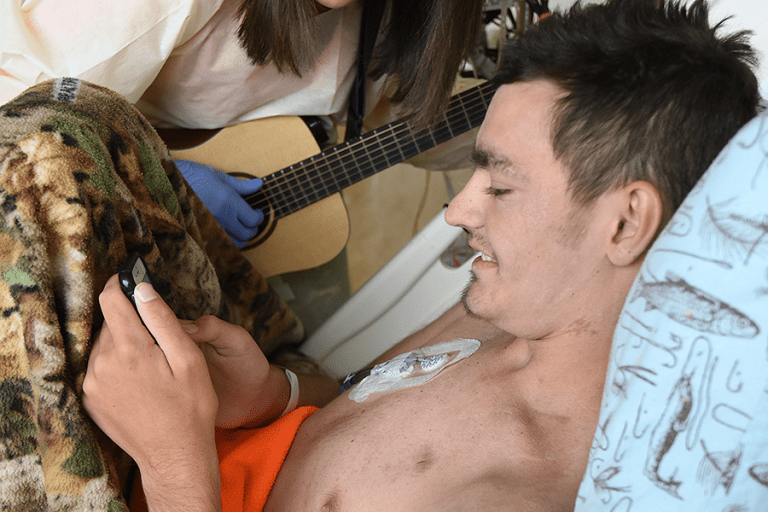RESEARCH HIGHLIGHTS
With world-class expertise and a proven track record of success, the University of Minnesota Masonic Cancer Center is advancing the study of childhood cancer. Researchers are discovering genes that increase the risk of cancer and related diseases and finding new, safer ways to treat cancers. Included here is a selection of research projects that donations from supporters like you helped fund this year.
PREVENTING GRAFT-VERSUS-HOST DISEASE WITH TARGETED SUPPRESSOR CELLS
Principal investigator: Bruce Blazar, MD
Graft-versus-host disease (GVHD) occurs when a patient’s immune system sees donor cells as different and attacks them, causing skin, liver, stomach and intestinal problems. GVHD can occur in up to 75 percent of patients receiving blood and marrow transplants, and it’s a major cause of serious illness or death.
Researchers have developed a new therapy that involves infusing a large number of suppressor cells that can inhibit GVHD. However, cell production is very costly and technically challenging, thereby limiting its widespread use. The goal of this project is to improve the ability of suppressor cells to get to the sites where GVHD initiates and causes tissue damage. The research team will do this by incubating suppressor cells with an enzyme that adds sugar to the cells’ surfaces, directing the cells to the sites of inflammation. In a second approach, researchers will place a receptor on the suppressor cell surface that targets the colon, a common site for GVHD origination.
If successful, a markedly fewer number of suppressor cells will be needed for infusion, and this technique will provide doctors with a new means to treat instances of GVHD that aren’t responsive to the current therapy: high-dose steroids that have significant side effects.
TREATING GRAFT-VERSUS-HOST DISEASE WITH CELLULAR THERAPIES
Principal investigator: Keli Hippen, PhD
The University of Minnesota has pioneered three cellular-therapy clinical trials utilizing regulatory T cells (Treg), the cell type responsible for preventing autoimmunity, or when the immune system mistakenly attacks a body’s own cells and tissue. These trials have the potential of helping not only blood and marrow transplant patients but also millions of organ transplant patients, as well as patients being treated for autoimmune disorders.
This project aims to capitalize on the U of M’s expertise and perform proof-of-concept experiments that will allow FDA approval to extend the scope of Treg cellular therapy. Researchers will: (1) determine whether Treg can be used to treat acute GVHD instead of just preventing it; (2) develop a protocol for inducing regulatory function in alloreactive enriched T-cell populations; and (3) induce regulatory T cells using reagents rapamycin and TFGß3.
GENERATING GENE-CORRECTED CELLS FOR STEM CELL TRANSPLANT
Principal investigator: Mark Osborn, PhD
The University of Minnesota Masonic Children’s Hospital is the single largest treatment center for Fanconi anemia (FA), a genetic disease that usually leads to cancer and bone marrow failure. A bone marrow transplant is typically a child’s best hope for treatment, but the usual complications of transplantation are further compounded for FA patients who have higher sensitivity to chemotherapy and radiation.
An ideal treatment regimen would be one that removed the side effects of a transplant, including GVHD. To achieve this, researchers will combine the cutting-edge technologies of genome editing and stem cell biology to develop side effect-free transplant protocols. Genome editing is accomplished by using highly specific individually tailored molecular scalpels that remove the portion of the DNA responsible for the genetic disorder and replace it with the normal copy. This approach will correct an individual patient’s cells and use the cells as a platform for the generation of blood progenitor cells.
The ability to perform genome editing in cells that can be transplanted back into the patient holds transformative potential for improving transplant and regenerative medicine. This strategy will use FA as a model, but the research is highly transferrable to multiple pediatric cancers and other disorders currently treated by stem cell transplants.
IMPROVING IMMUNE RECOVERY AFTER TRANSPLANT
Principal investigator: Heather Stefanski, MD, PhD
Leukemia accounts for 30 percent of childhood cancers, and although many children who undergo chemotherapy to treat leukemia can be cured, there is a subset of high-risk patients who relapse or never go into remission. For those patients, a cure can be achieved only with a stem cell transplant, but transplantation poses the risk of immunodeficiency, which can lead to infections and relapse. Unfortunately, there is an unmet need in current therapy, as certain immune responses can be treated only with an intact immune system, not medication.
The goal of this research is to utilize expanded stem cells from umbilical-cord blood as a source to generate T cells in vitro. T cells are critical components of the immune system and are required to fight viruses and fungi and prevent relapse. These cells will then be tested in mouse models.
If the research is successful, this approach could be used to help boost the immune systems of bone marrow transplant patients, thereby decreasing the risk of serious complications and death.
THE ROLE OF UHRF2 IN B-CELL LYMPHOMAS
Principal investigator: Tim Hallstrom, PhD
Lymphomas are the third most common form of cancer among children, and most B-cell lymphomas (which include Hodgkin and non-Hodgkin) arise from germinal center B cells. Germinal centers are sites where mature cells can grow, develop and change during a normal immune response to infection.
This project will study why the epigenetic “reader” protein called UHRF2 is unregulated in germinal centers and whether suppression of its expression contributes to pediatric lymphomas. Epigenetic modifying drugs, such as decitabine and azacytidine, are widely used in adults with blood cancers and have demonstrated safety and efficacy in numerous patients.
Researchers hypothesize that these drugs will likely also prove to be effective for pediatric cancer patients, once there is a better understanding how these medications kill cancer cells and which genetic types of pediatric malignancies they eliminate.
IDENTIFYING GENETIC VARIANTS ASSOCIATED WITH HEPATOBLASTOMA
Principal investigator: Jenny Poynter, PhD, MPH
Hepatoblastoma (HB) is a liver tumor that initiates while a baby is still inside the womb and occurs most commonly in children under five years of age. Very little is known about the causes of HB, though it is suspected that genetic factors play a role in the likelihood of this cancer.
The hypothesis of this project is that both common and moderately rare genetic variants increase the risk of developing HB. In addition, because HB begins in utero, maternal genetic variation may also increase susceptibility to it. Researchers have collected DNA samples from 492 HB patients and their parents, and the study—the first of its kind—will analyze genetic variants to identify those that increase risk of HB.
Identification of variants associated with HB risk will improve our understanding of the causes of this cancer, suggest avenues for prevention and ultimately lead to new treatment strategies that will improve patient outcomes. In particular, the results of this study may lead to screening or prevention studies in low-birth-weight infants who have the highest risk of developing HB.




